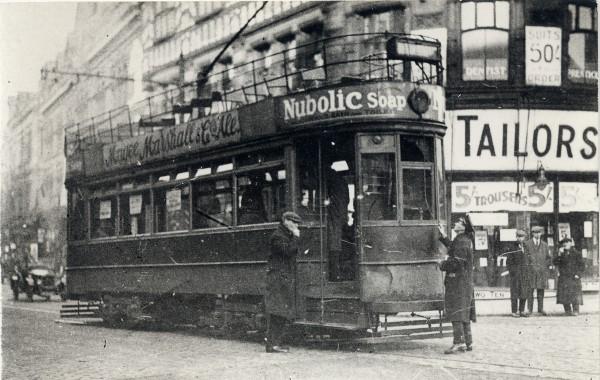Wigan Album
Wigan Corporation Tramways
20 Comments
Photo: RON HUNT
Item #: 23482
Had quite a few pubs in Wigan,and district,Magee Marshal. Almond's, Walker's, and Wilson's, suited me more.
"Nubolic Soap" I bet that did you a world of good.
Ann. Don't even know what nubolic means.No mention of it in the dictionary.
Fifty bob tailors...dentist upstairs. Years later became Jackson the tailor
I presume that NUBOLIC SOAP was one step up from CARBOLIC SOAP<g>
It had the nickname of 2-10 tailors..(£2.10s)
The Fifty Shilling Tailor in my day was John Collier...there used to be a jingle on the TV advert...John Collier, John Collier, the window to watch....!
Nubolic Soap was made by Joseph Watson & Sons in Leeds.
From the Nursing Record 7 September 1893:
"‘I NUBOLIC” SOAP.
(Messrs. JOSEPH WATSON Sr SONS, Whitehall Soap
Works, Leeds.)
Our attention has been drawn to this soap for all
household purposes, and we cannot speak too
highly in its favour as regards laundry work, for it
contains many qualities which render it of great
value in destroying the infectious germs that so
often cling to soiled linen. It is advisable when
using it for such clothes to first dissolve the
quantity required in hot water, then when the clothes
have been allowed to steep in it, they can be washed
and boiled in the ordinary way, which, together
with the use of this soap, will destroy any possibility
of contagion even after fever, small-pox, and all
such infectious diseases. Added to this, its
free use in the house is most advantageous, and
stairs and rooms scrubbed with the ‘‘ Nubolic ”
‘Soap gives off that refreshing odour which so well
defines clean linen."
George Well done for finding this.
Is no knowledgeable WW'r going to post to tell us all about the tram then?
This is the narrow-gauge bogie car, No.26. Photo taken about 1924, and attributed to Greater Manchester Transport. If you look at the trolley pole, you'll see that the tram is proceeding down Market Street from Market Place.
Thanks Loz.
Methinks the soap and the tailors had stolen the show: Ahh the power of advertising.
I agree A.P. and Loz. The main item of interest is the tram, but comments relative to the other items depicted on the photograph make for interesting debate,and learning.
Totally agree Albert, the whole lot is interesting. In Wigan, the real value, was not the fifty shillings tailor, but having a friend working at Coops. When trade was quiet, they could get you a 'House Job' real bargain, high quality, made-to-measure suit. I think they maintained a small measuring and fitting room on Mesnes Street, but half a century, is too long for accurate memory.
I see that the trams in Wigan had two overhead wires and dual contacts. Was this used often? The trams I remember had
single wires with the rails as a return for power.
Only the trolley buses had two overhead wires. A tram only needs one, as the negative conductor is the track itself.
John:
I think the two wires are for trams passing in either direction. If you enter tram, in search box above, you will get a range of views. No close up of connector, but on balance, I would say single. You may well see photos, or remember twin wire system, as trolley buses used it.
If John is referring to the second arm which can be seen over the rear of the tram, that is in fact the arm of the kerbside gantry carrying the wires.
The gantry can be seen in other photographs of this location.
AP is quite correct. Each tram track needs a single positive overhead wire, so where two parallel tracks exis, there are two wires. A trolley bus needs a positive wire and a negative wire as it doesn't run on tracks.
Thank you for your comments. As stated the two wires must
have been for passing trams.